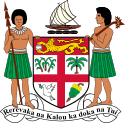1987 Fijian general election
| |||||||||||||||||||||||||||||||
All 52 seats in the House of Representatives 26 seats needed for a majority | |||||||||||||||||||||||||||||||
|---|---|---|---|---|---|---|---|---|---|---|---|---|---|---|---|---|---|---|---|---|---|---|---|---|---|---|---|---|---|---|---|
| |||||||||||||||||||||||||||||||
| |||||||||||||||||||||||||||||||
 |
|---|
General elections were held in Fiji between 4 and 11 April 1987.[1] They marked the first electoral transition of power in Fijian history. Despite receiving just under 50% of the vote, the Alliance Party of longtime prime minister, Kamisese Mara was defeated by a coalition of the Fiji Labour Party (contesting a general election for the first time) and National Federation Party, which won 28 seats to the Alliance's 24.[2] The Labour Party's Timoci Bavadra became prime minister.
Bavadra's 28-member parliamentary caucus included only seven ethnic Fijians, all of them elected with predominantly Indo-Fijian support from national constituencies. His fourteen-member cabinet included six Fijians, seven Indo-Fijians and one European. Effective Indo-Fijian control of the government caused widespread resentment among the ethnic Fijian community, and after less than a month in office, the new government was deposed on 14 May in a coup d'état led by Lieutenant-Colonel Sitiveni Rabuka.
Electoral system
[edit]The 52 members of the House of Representatives were elected from two types of constituency, with candidature in each limited to one of three ethnic groups; Fijians, Indo-Fijians and General electors, generally of European or Chinese descent.
Twenty-seven members were elected from communal constituencies (12 Fijians, 12 Indo-Fijians and 3 general) in which voters voted for someone of their own ethnicity, with the remaining twenty-five elected from national constituencies (10 Fijian, 10 Indo-Fijian and 5 general) in which candidature was limited by ethnicity but all registered voters in a constituency could vote for.
Results
[edit]| Party | Votes | % | Seats | +/– | |
|---|---|---|---|---|---|
| Alliance Party | 484,543 | 49.46 | 24 | −4 | |
| FLP–NFP | 461,056 | 47.07 | 28 | +6 | |
| Fijian Nationalist Party | 14,484 | 1.48 | 0 | 0 | |
| Western United Front | 8,339 | 0.85 | 0 | −2 | |
| National Federation Party-Koya | 4,462 | 0.46 | 0 | New | |
| Independents | 6,723 | 0.69 | 0 | 0 | |
| Total | 979,607 | 100.00 | 52 | 0 | |
| Valid votes | 979,607 | 97.78 | |||
| Invalid/blank votes | 22,238 | 2.22 | |||
| Total ballots cast | 250,968 | – | |||
| Registered voters/turnout | 353,691 | 70.96 | |||
| Source: Nohlen et al. | |||||
Aftermath
[edit]Following the elections Bavadra formed a fourteen-member cabinet.[3]
| Bavadra cabinet | |
|---|---|
| Position | Minister |
| Prime Minister Minister for Public Service Minister for Fijian Affairs Minister for Home Affairs |
Timoci Bavadra |
| Deputy Prime Minister Minister for Housing and Urban Affairs Minister for Information |
Harish Sharma |
| Attorney General Minister for Justice |
Jai Ram Reddy |
| Minister for Agriculture, Fisheries and Forestry | Joeli Nacola |
| Minister for Communications, Transport and Works | Ahmed Bhamji |
| Minister for Education, Youth and Sport | Tupeni Baba |
| Minister of Finance and Economic Planning | Mahendra Chaudhry |
| Minister for Foreign Affairs and Civil Aviation | Krishna Datt |
| Minister for Health and Social Welfare | Satendra Nandan |
| Minister for Labour and Immigration | Joeli Kalou |
| Minister for Lands, Energy and Mineral Resources | Mosese Volavola |
| Minister for Trade, Industry and Tourism | Navin Maharaj |
| Minister of State for Cooperatives and Consumer Affairs | Chris Herbert |
| Minister of State for Rural Development, Rehabilitation and Relief | Temo Sukanaivalu |
See also
[edit]References
[edit]- ^ Dieter Nohlen, Florian Grotz & Christof Hartmann (2001) Elections in Asia: A data handbook, Volume II, p653 ISBN 0-19-924959-8
- ^ Lal, Victor (1 December 1987). "The Fiji general election of 1987". Electoral Studies. 6 (3): 249–262. doi:10.1016/0261-3794(87)90035-7. ISSN 0261-3794.
- ^ Fiji's younger and smaller cabinet Pacific Islands Monthly, June 1987, p20


